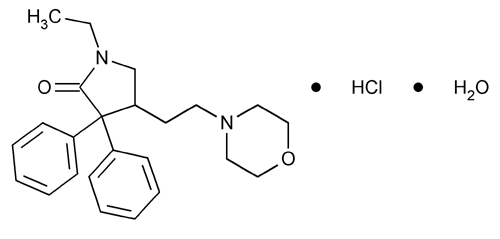Doxapram Hydrochloride
2-Pyrrolidinone, 1-ethyl-4-[2-(4-morpholinyl)ethyl]-3,3-diphenyl-, monohydrochloride, monohydrate, (±)-.
(±)-1-Ethyl-4-(2-morpholinoethyl)-3,3-diphenyl-2-pyrrolidinone monohydrochloride monohydrate
Anhydrous 414.98
» Doxapram Hydrochloride, dried at 105 for 2 hours, contains not less than 98.0 percent and not more than 100.5 percent of C24H30N2O2·HCl.
for 2 hours, contains not less than 98.0 percent and not more than 100.5 percent of C24H30N2O2·HCl.
Packaging and storage—
Preserve in tight containers.
Identification—
Solution:
400 µg per mL.
Medium:
water.
Absorptivities at 258 nm, calculated on the dried basis, do not differ by more than 3.0%.
pH  791
791 :
between 3.5 and 5.0, in a solution (1 in 100).
:
between 3.5 and 5.0, in a solution (1 in 100).
Loss on drying  731
731 —
Dry it at 105
—
Dry it at 105 for 2 hours: it loses between 3.0% and 4.5% of its weight.
for 2 hours: it loses between 3.0% and 4.5% of its weight.
Residue on ignition  281
281 :
not more than 0.3%.
:
not more than 0.3%.
Heavy metals, Method II  231
231 :
0.002%.
:
0.002%.
Chromatographic purity—
Dragendorff reagent—
Dissolve 17 g of bismuth subnitrate and 200 g of tartaric acid in 800 mL of water (Solution A). Dissolve 160 g of potassium iodide in 400 mL of water (Solution B). Mix Solution A and Solution B. To 25 mL of this stock solution add 50 g of tartaric acid and 250 mL of water, and mix.
Test preparation—
Dissolve 57 mg of Doxapram Hydrochloride in 0.5 mL of 0.1 N sodium hydroxide, add 1.0 mL of chloroform, and shake.
Standard preparation A—
Dissolve 57 mg of USP Doxapram Hydrochloride RS in 0.5 mL of 0.1 N sodium hydroxide, add 1.0 mL of chloroform, and shake.
Standard preparation B—
Dissolve 11.4 mg of USP Doxapram Hydrochloride RS in 0.5 mL of 0.1 N sodium hydroxide, add 100 mL of chloroform, and shake.
Procedure—
Apply 10-µL portions of the chloroform solutions obtained from the Test preparation and the Standard preparations to a suitable thin-layer chromatographic plate (see Chromatography  621
621 ) coated with a 0.25-mm layer of chromatographic silica gel mixture. Allow the spots to dry, and develop the chromatogram in a chromatographic chamber lined with paper and equilibrated with a solvent system consisting of a mixture of isopropyl alcohol and 1 N ammonium hydroxide (4:1) until the solvent front has moved about three-fourths of the length of the plate. Remove the plate from the developing chamber, mark the solvent front, and allow the solvent to evaporate. Spray the plate with Dragendorff reagent in order to visualize the spots: the RF value of the principal spot obtained from the Test preparation corresponds to that obtained from Standard preparation A, and no spot, other than the principal spot, in the chromatogram of the Test preparation is larger or more intense than the principal spot obtained from Standard preparation B (0.2%).
) coated with a 0.25-mm layer of chromatographic silica gel mixture. Allow the spots to dry, and develop the chromatogram in a chromatographic chamber lined with paper and equilibrated with a solvent system consisting of a mixture of isopropyl alcohol and 1 N ammonium hydroxide (4:1) until the solvent front has moved about three-fourths of the length of the plate. Remove the plate from the developing chamber, mark the solvent front, and allow the solvent to evaporate. Spray the plate with Dragendorff reagent in order to visualize the spots: the RF value of the principal spot obtained from the Test preparation corresponds to that obtained from Standard preparation A, and no spot, other than the principal spot, in the chromatogram of the Test preparation is larger or more intense than the principal spot obtained from Standard preparation B (0.2%).
Assay—
Dissolve about 800 mg of Doxapram Hydrochloride, previously dried and accurately weighed, in 50 mL of glacial acetic acid, add 1 drop of crystal violet TS and 10 mL of mercuric acetate TS, and titrate with 0.1 N perchloric acid VS to a blue-green endpoint. Perform a blank determination, and make any necessary correction. Each mL of 0.1 N perchloric acid is equivalent to 41.50 mg of C24H30N2O2·HCl.
Auxiliary Information—
Please check for your question in the FAQs before contacting USP.
| Topic/Question | Contact | Expert Committee |
| Monograph | Ravi Ravichandran, Ph.D.
Senior Scientist 1-301-816-8330 |
(MDPP05) Monograph Development-Psychiatrics and Psychoactives |
| Reference Standards | Lili Wang, Technical Services Scientist 1-301-816-8129 RSTech@usp.org |
USP32–NF27 Page 2204
Pharmacopeial Forum: Volume No. 29(6) Page 1874
